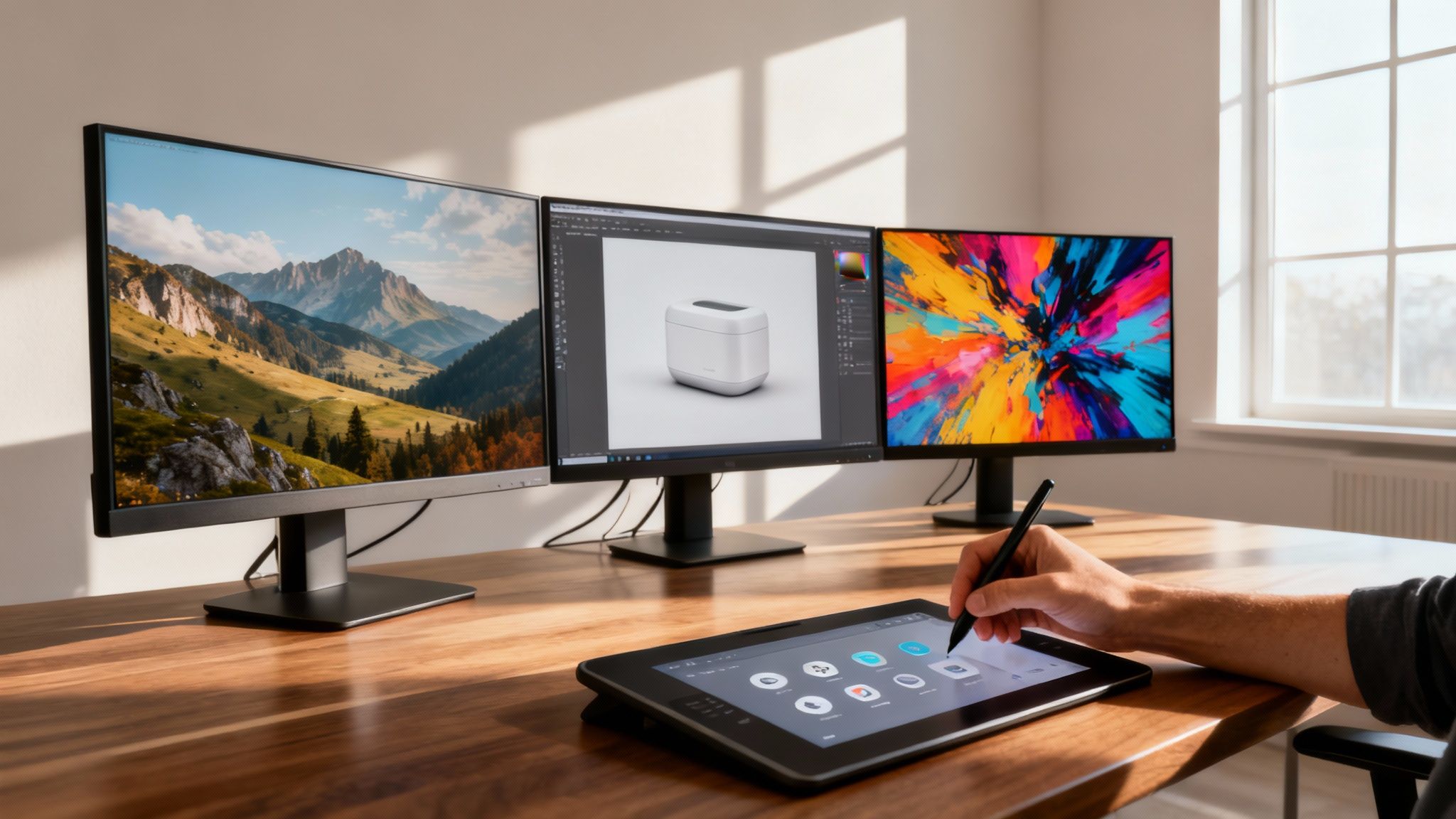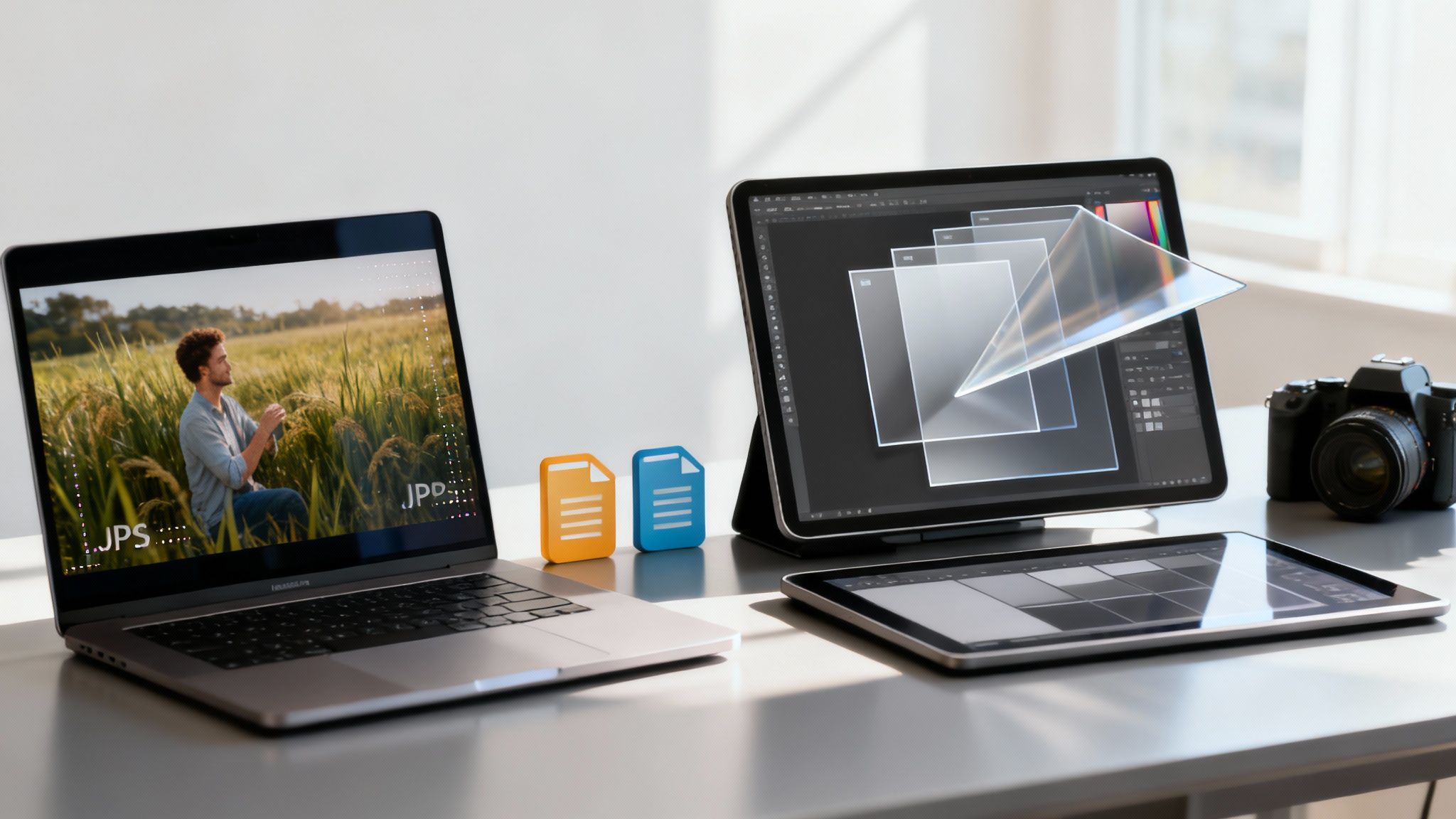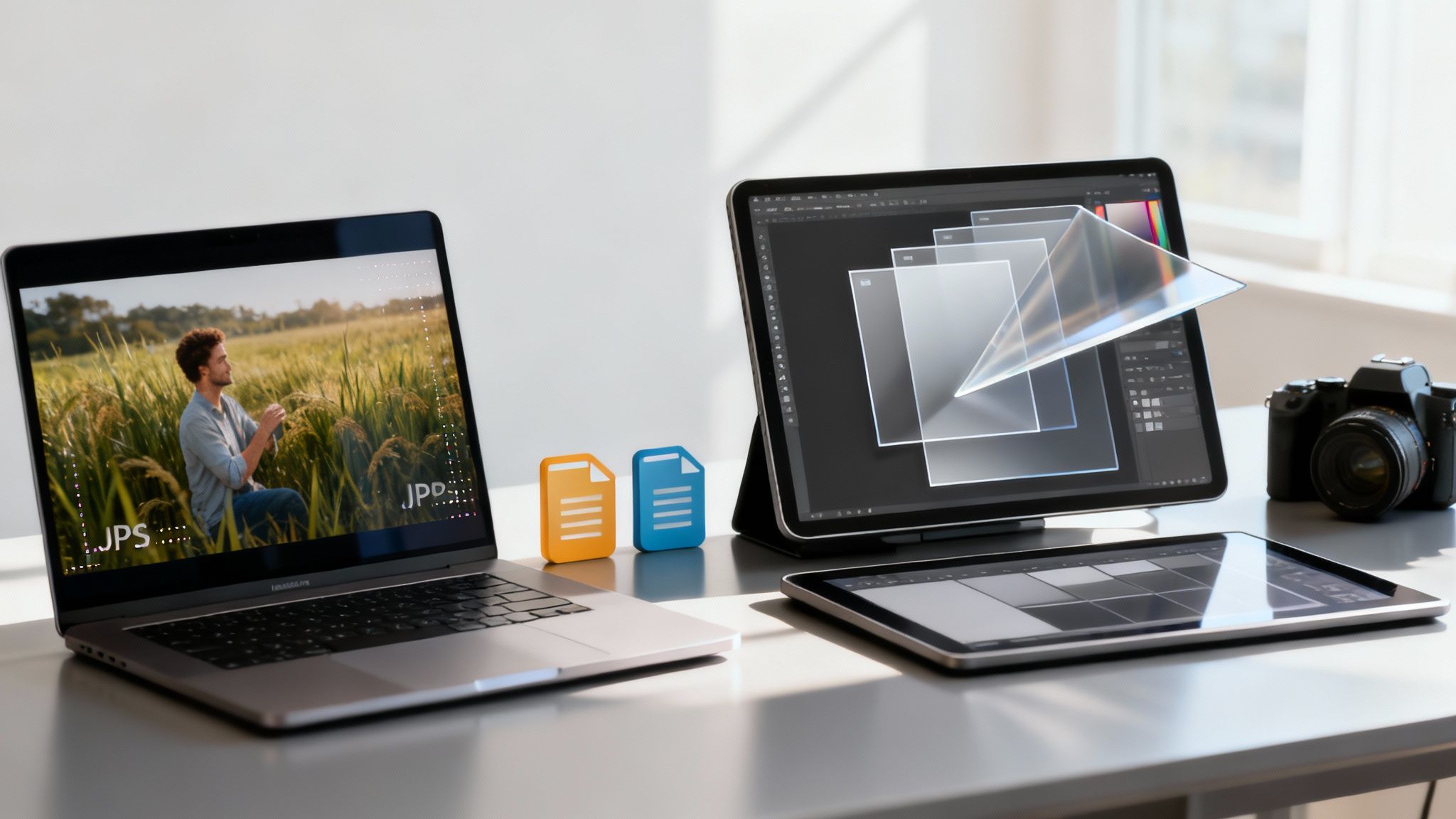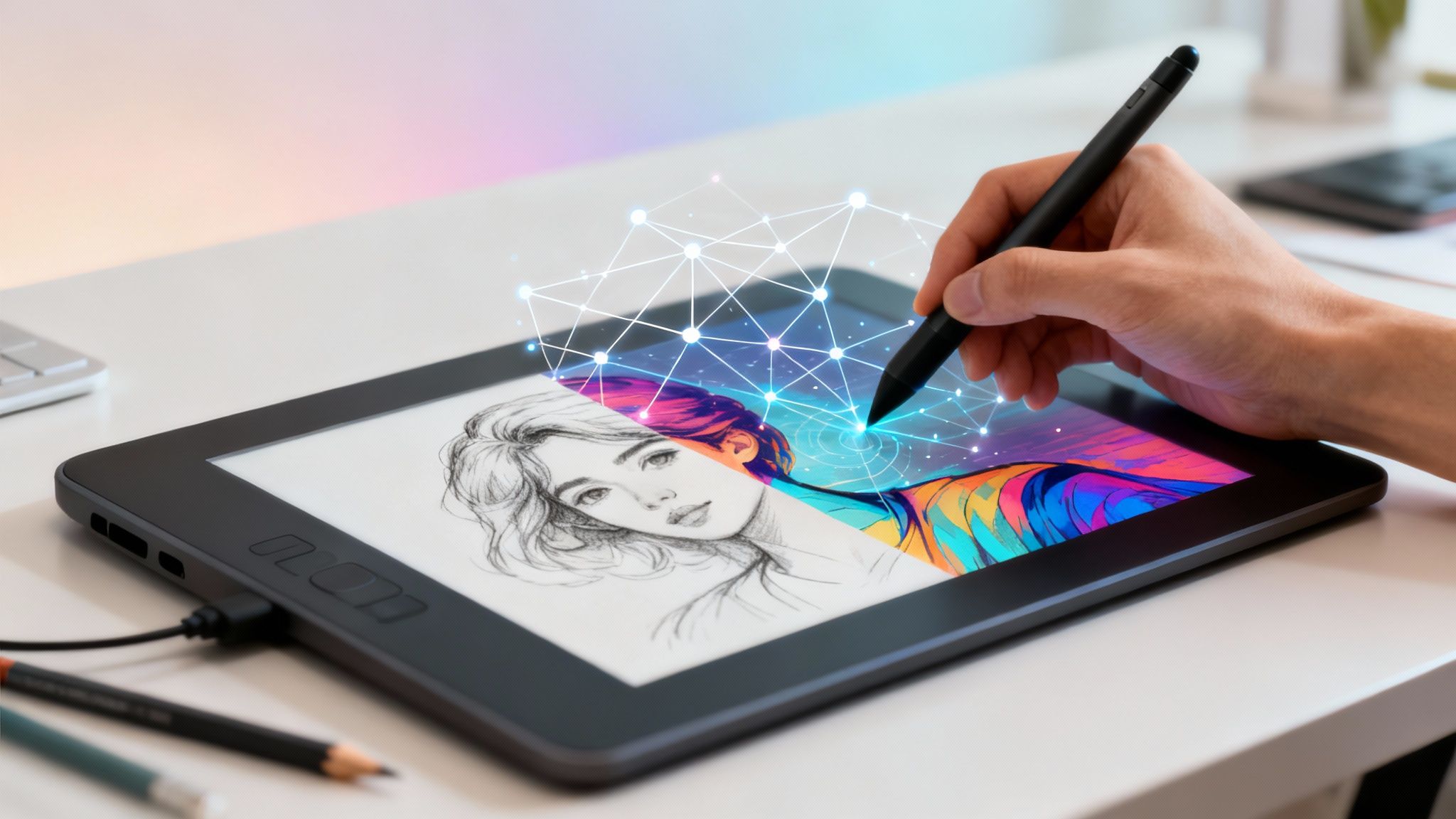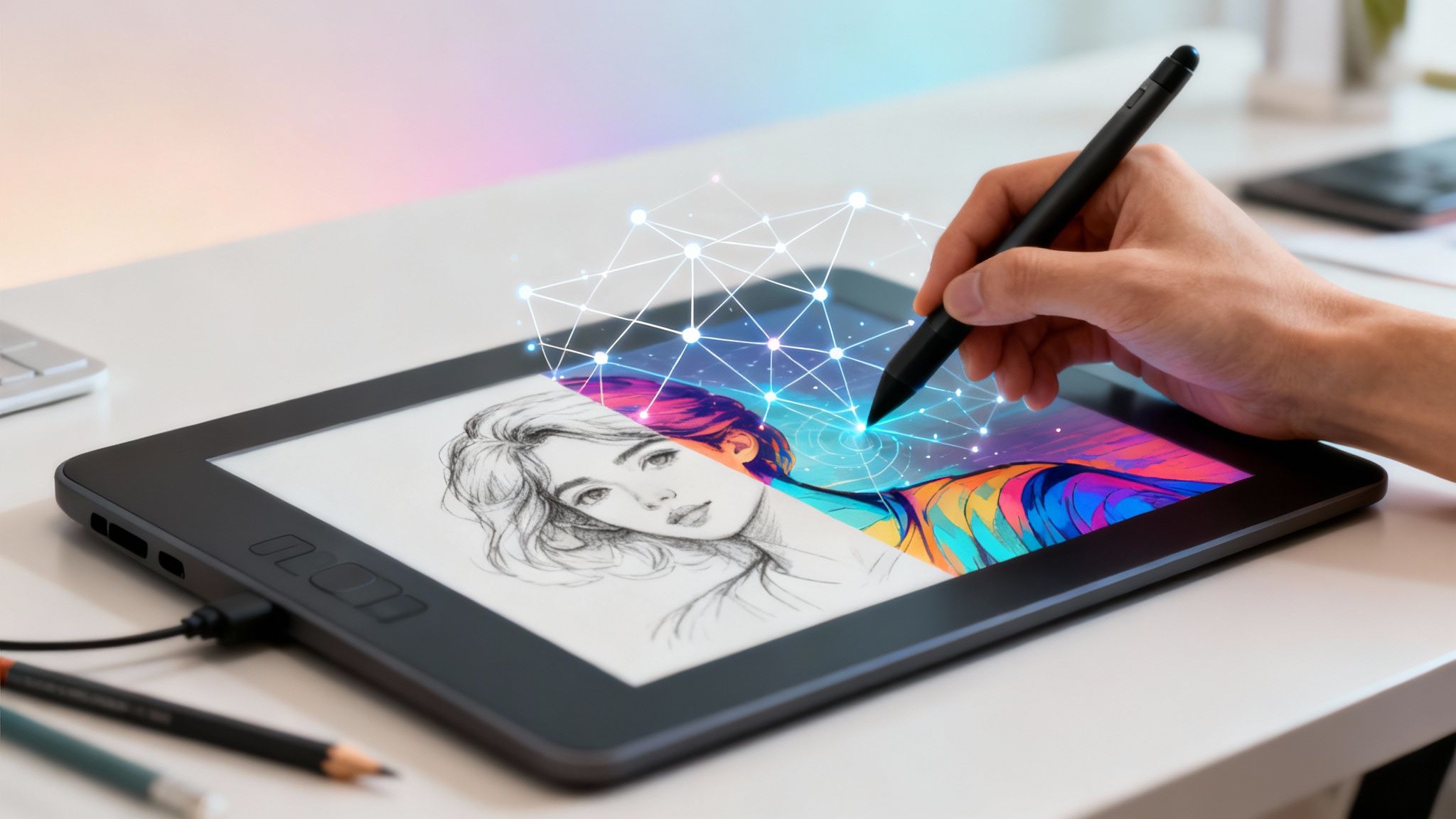The landscape of AI-powered creative tools is evolving rapidly, offering powerful new ways to generate visual concepts. For professional studios and creative teams, selecting the right tool isn't just about output quality; it's about compliance, workflow integration, and responsible usage. This guide evaluates the 12 best free AI image generators available today, focusing on their practical applications for enterprise environments. Our goal is to provide a clear, balanced overview to help your team make informed decisions when integrating generative AI into your creative process.
We will explore each platform's features, limitations, and how they align with the needs of a modern, safety-conscious creative workflow. Every entry includes detailed analysis, screenshots, and direct links to help you quickly assess whether a tool is right for your project. This article is structured to help you find the ideal generator for specific tasks, from initial concept art for game developers to marketing visuals for creative directors. We focus on real-world use cases to ensure every asset is both innovative and responsibly produced.
For creative professionals seeking a deeper understanding of the broader generative AI landscape and how these technologies are applied beyond image creation, resources like a guide on building generative AI-powered apps can provide valuable technical context. Now, let’s explore the top platforms.
1. Microsoft Designer – Image Creator
As a successor to the popular Bing Image Creator, Microsoft Designer provides one of the most accessible and high-quality entry points into AI image generation. It leverages powerful models like DALL·E 3 directly within your browser, making it an excellent no-install option for creative teams needing quick visualisations or marketers producing social media assets. Its direct integration with the broader Microsoft ecosystem, including Copilot, streamlines the creative workflow considerably.
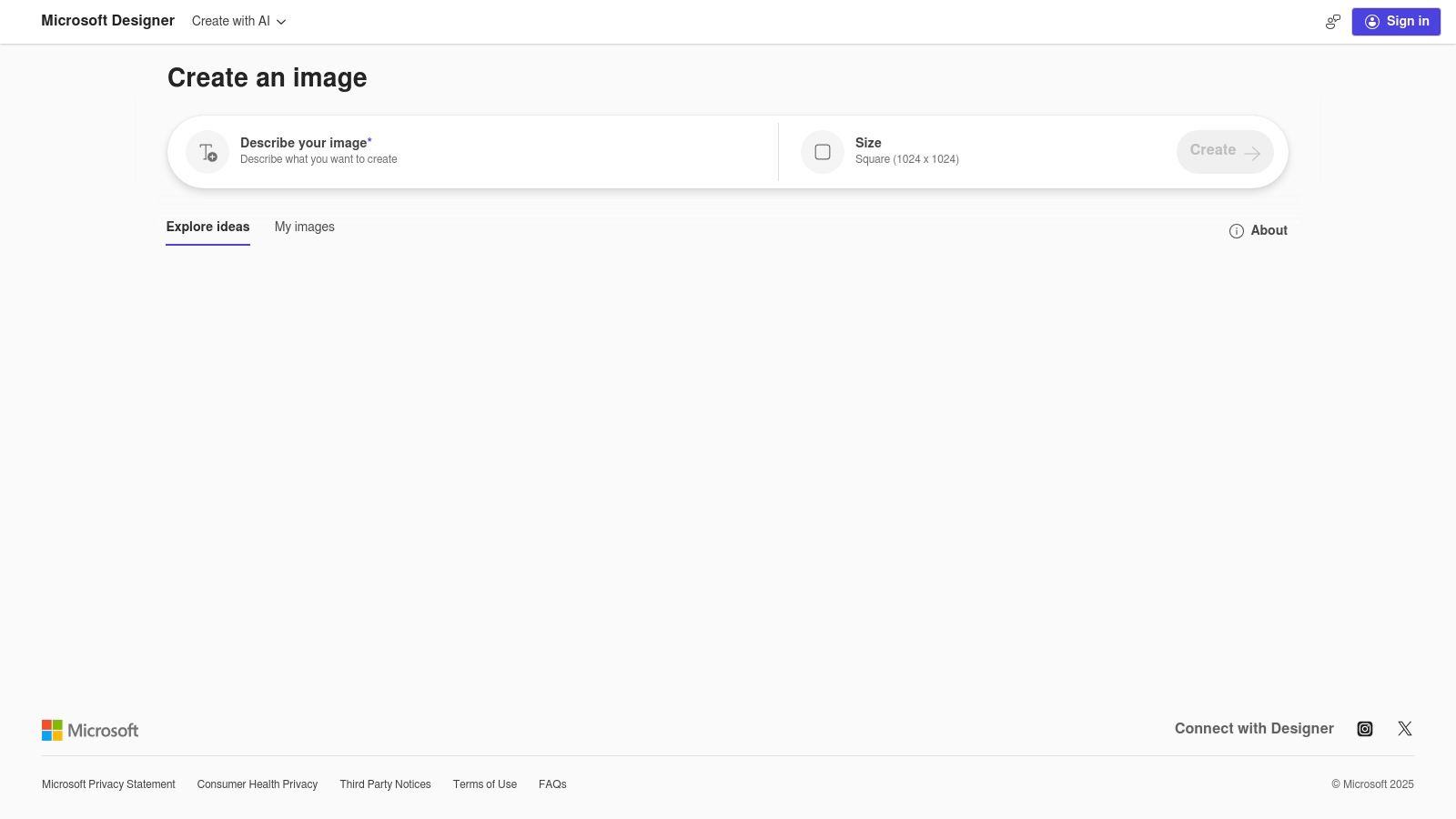
What sets it apart is the seamless transition from generation to editing. Once an image is created, you can immediately open it in the Designer canvas to add text, apply filters, or incorporate it into a larger design without leaving the platform. This tight integration makes it one of the best free AI image generators for users who need a complete, end-to-end solution. The platform operates on a generous credits model, providing a substantial number of fast generations per month with a free Microsoft account.
Key Features and Considerations
Website: designer.microsoft.com/image-creator
2. Adobe Firefly
As a core component of Adobe's creative suite, Firefly stands out for its enterprise-grade compliance and seamless integration into professional workflows. It is trained on Adobe Stock images and openly licensed content, making it a commercially safe option for businesses and creative teams. Firefly offers a suite of generative tools, including powerful text-to-image generation, Generative Fill, and Generative Extend, accessible directly through its web interface or within flagship apps like Photoshop and Express.

This deep integration makes Adobe Firefly one of the best free AI image generators for professionals already invested in the Adobe ecosystem. The ability to generate an asset in the Firefly web app and then seamlessly hand it off to Photoshop for detailed refinement is a significant advantage. The platform uses a credit-based system; the free tier provides a monthly allotment of credits, which are used for standard-resolution generations, while higher-resolution outputs and premium features may require a paid plan.
Key Features and Considerations
Website: www.adobe.com/products/firefly.html
3. Ideogram
Ideogram has carved out a distinct niche by excelling at one of AI image generation's most common challenges: rendering coherent and stylistically integrated text. This makes it an invaluable tool for creating posters, logos, memes, or any visual that requires typography to be a core part of the image itself. Instead of producing garbled letters, Ideogram’s model is specifically trained to generate clear, legible text that matches the prompt's aesthetic, a feature that sets it apart from many competitors.
While many platforms struggle with text, Ideogram’s reliable typography rendering solidifies its position as one of the best free AI image generators for graphic designers and marketers. The platform operates on a simple, browser-based interface where users can select stylistic tags like "typography," "poster," or "3D render" to guide the output. The free plan provides a modest weekly credit allowance, which is sufficient for exploring its unique capabilities, though paid plans offer faster generation, private sessions, and higher volume for professional use.
Key Features and Considerations
Website: ideogram.ai
4. Leonardo.ai
Leonardo.ai is a comprehensive creative suite that appeals to users who want granular control over their AI-generated visuals. More than just a simple text-to-image tool, it offers a robust platform for everything from initial image creation and real-time canvas editing to training custom models on your own datasets. This makes it a powerful option for game developers, artists, and creative teams looking to establish a consistent visual style or generate specific assets like textures and concept art.
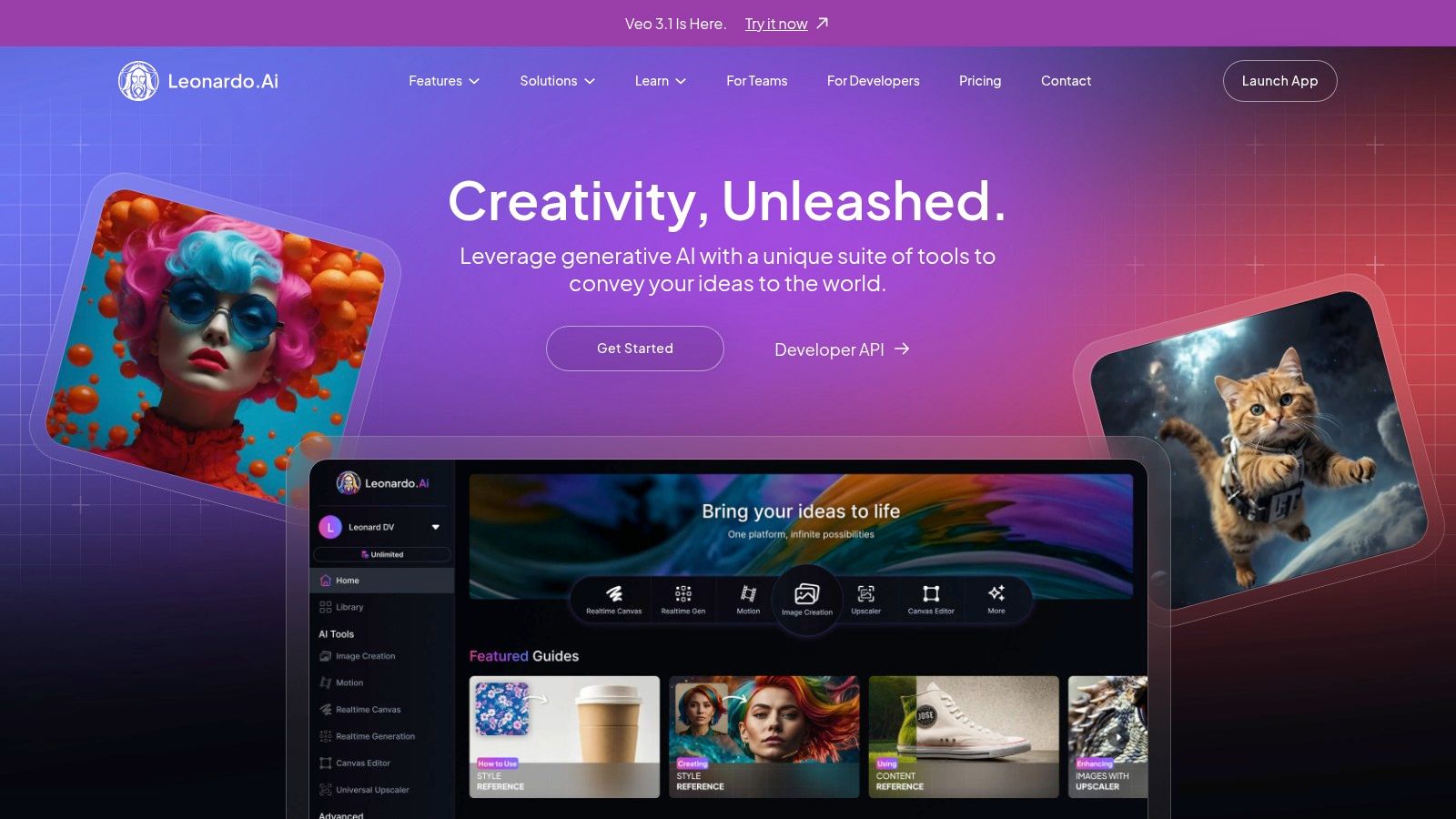
The platform stands out with its generous free tier, providing a daily allotment of "Fast Tokens" that refresh every 24 hours. Users can access a wide range of community-trained models or use advanced features like "Alchemy" and "Prompt Magic" to enhance the quality and coherence of their outputs. Its all-in-one nature, combining generation, upscaling, and editing, positions Leonardo.ai as one of the best free AI image generators for creators who need a full toolkit and are willing to engage with more advanced settings.
Key Features and Considerations
Website: https://leonardo.ai
5. NightCafe Studio
NightCafe Studio stands out as a long-running and community-focused platform in the AI art space. It provides a unique, gamified experience where users can earn free credits daily through participation in challenges and community activities. This earn-as-you-go model makes it a reliable choice for casual creators and hobbyists who want to experiment with various AI models without a significant upfront investment. It offers a diverse range of generation methods, including text-to-image and style transfer, appealing to a broad creative audience.

What makes NightCafe one of the best free AI image generators is its transparent and predictable credit system. Users always know how many credits an image will cost, and the platform offers numerous ways to replenish them for free. Its availability on both web and mobile apps (iOS/Android) ensures that creativity isn't tethered to a desktop. While free users may occasionally encounter queues during peak periods, the active community and consistent pathway to free creation make it a compelling and accessible option for continuous artistic exploration.
Key Features and Considerations
Website: nightcafe.studio
6. Canva – Magic Studio
Canva’s Magic Studio integrates AI image generation directly into one of the world's most popular design ecosystems. Rather than being a standalone tool, its text-to-image and generative fill features are embedded within the familiar Canva workflow. This makes it an ideal choice for marketers, social media managers, and small business owners who need to create visuals and immediately place them into presentations, social media posts, or marketing materials without switching applications.

The platform’s key advantage is its all-in-one environment. You can generate an image and instantly apply it to thousands of professional templates, add text, or use other design elements. Canva also provides clear AI product terms and robust licensing documentation, which is a significant consideration for enterprise users concerned with compliance and safe asset usage. While its free tier offers a taste of the AI capabilities, many of the more advanced Magic Studio tools are reserved for Pro subscribers, making the free usage limits feel somewhat restrictive for power users. This makes it one of the best free AI image generators for those already invested in its platform.
Key Features and Considerations
Website: www.canva.com/magic/
7. Picsart AI Image Generator
Picsart is a household name in mobile and web-based photo editing, and its AI Image Generator extends this legacy into the generative space. It’s an ideal all-in-one solution for creators who want to generate, edit, and export visuals within a single, familiar ecosystem. The platform bundles its text-to-image capabilities directly with a robust suite of editing tools, including background removal, upscaling, and various stylisation filters, making it a powerful choice for social media content and quick creative projects.

What makes Picsart stand out is its seamless integration of generative AI within a comprehensive creative workflow. Users can immediately take a generated image and incorporate it into a larger design using templates, add text, or apply artistic effects without switching apps. While the free plan’s weekly credit allowance is modest, it provides a fantastic entry point for those new to AI. For professionals needing more, the paid tiers offer a significant increase in AI credits and access to a vast library of stock assets, making it one of the best free AI image generators for an integrated generate-and-edit experience.
Key Features and Considerations
Website: picsart.com/ai-art-generator
8. Craiyon
Originally known as DALL·E mini, Craiyon serves as a highly accessible and completely free entry point for anyone curious about AI image generation. It requires no sign-up for its base model, making it an excellent tool for quick experimentation, learning the fundamentals of prompt engineering, or generating rough concepts without any commitment. Its simplicity is its core strength, offering a straightforward text-to-image experience directly in your browser.
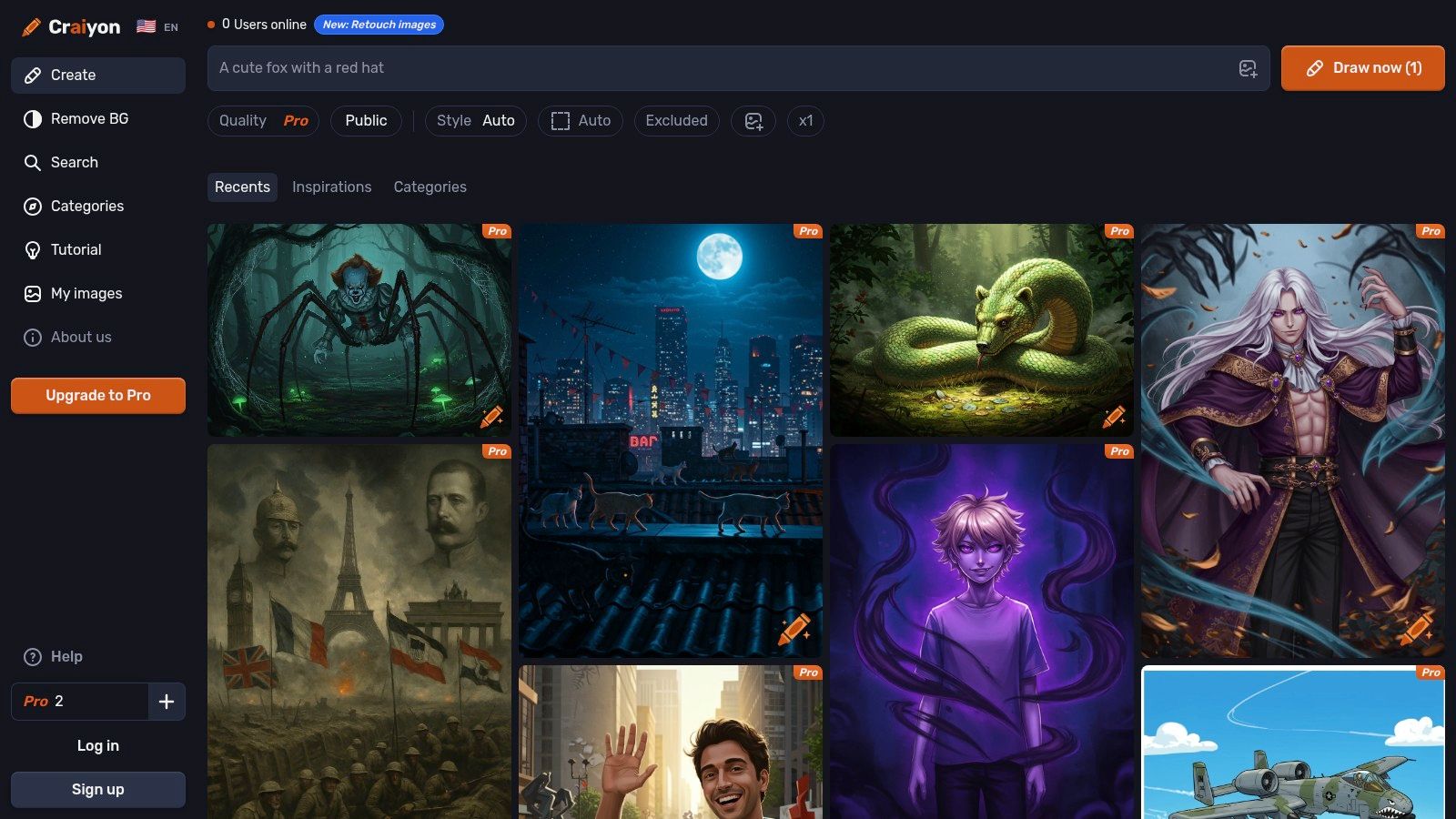
While the free version's quality is not on par with premium models like DALL·E 3, it excels as a no-risk learning environment. Users can test prompt ideas rapidly to see how an AI interprets them before using credits on more powerful platforms. For those needing higher quality, faster speeds, and more aspect ratios, Craiyon offers affordable subscription plans. This makes it one of the best free AI image generators for beginners and those needing a fast, simple tool for basic idea visualisation.
Key Features and Considerations
Website: https://www.craiyon.com
9. Mage Space
Mage Space is a community-driven web platform that provides powerful, browser-based access to a wide array of open-source models like Stable Diffusion, SDXL, and FLUX. It stands out by offering advanced creative controls, typically requiring a local installation, directly in a free-to-use workspace. This makes it an ideal choice for artists and developers who want to experiment with sophisticated techniques like ControlNet and LoRAs without the technical overhead of setting up their own environment.
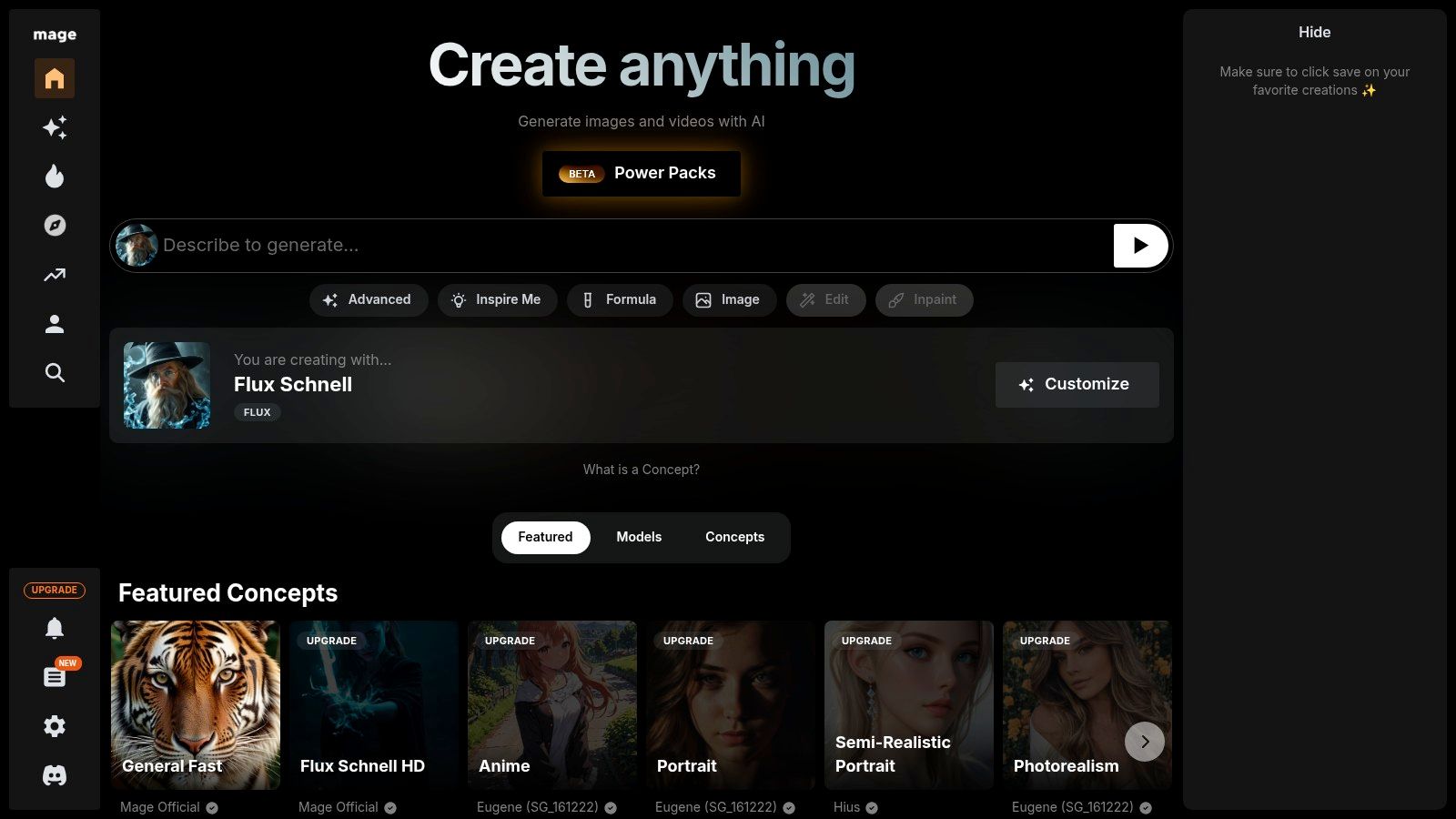
The platform is favoured for its balance of accessibility and depth, allowing for fast, free experimentation while still offering the granularity needed for professional-grade work. The public gallery and community leaderboards offer a constant stream of inspiration and insight into effective prompting. While the free tier is generous, it's important to note that "unlimited" claims can be subject to fair-use throttling during peak times, which is a practical consideration for enterprise teams relying on consistent availability. Its comprehensive toolset cements its position as one of the best free AI image generators for open-model exploration.
Key Features and Considerations
Website: www.mage.space
10. Hugging Face Spaces – Image Generation Directory
For those who want to explore beyond mainstream tools, Hugging Face Spaces serves as an expansive and ever-changing library of community-hosted AI models. It is less a single generator and more of a massive, interactive directory where developers showcase everything from foundational models like Stable Diffusion XL to highly specialised, fine-tuned variants. This makes it an invaluable resource for technically-minded creatives and developers who want to test the capabilities of specific models without any local installation.
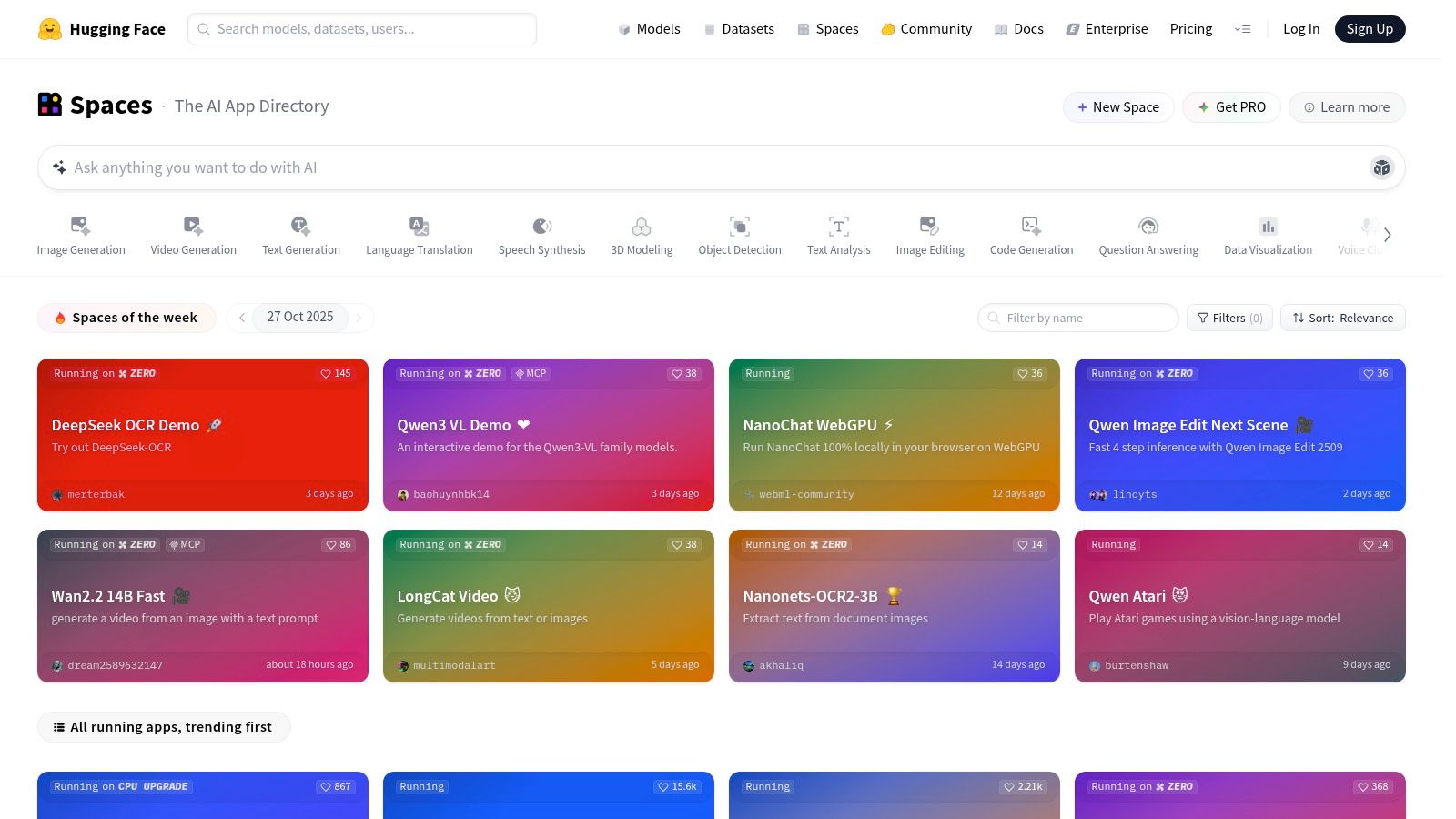
What makes Hugging Face a unique entry on this list of best free AI image generators is its sheer variety. You can experiment with hundreds of different image generation applications side-by-side, each offering a unique artistic style or technical function. While individual "Spaces" can have usage queues or go inactive, the platform provides an unparalleled, hands-on way to understand how different models operate by engaging directly with them. It's the perfect environment for experimentation and discovery before committing to a specific workflow or API.
Key Features and Considerations
Website: huggingface.co/spaces
11. Tensor.art
For users wanting to experiment with the vast ecosystem of custom Stable Diffusion models without a local setup, Tensor.art offers a compelling solution. It functions as both a generation tool and a community hub where creators can share and run a massive catalogue of SD/SDXL checkpoints and LoRAs directly in the browser. This makes it an ideal platform for exploring niche artistic styles, character concepts, or specific aesthetics that mainstream generators might not cover.
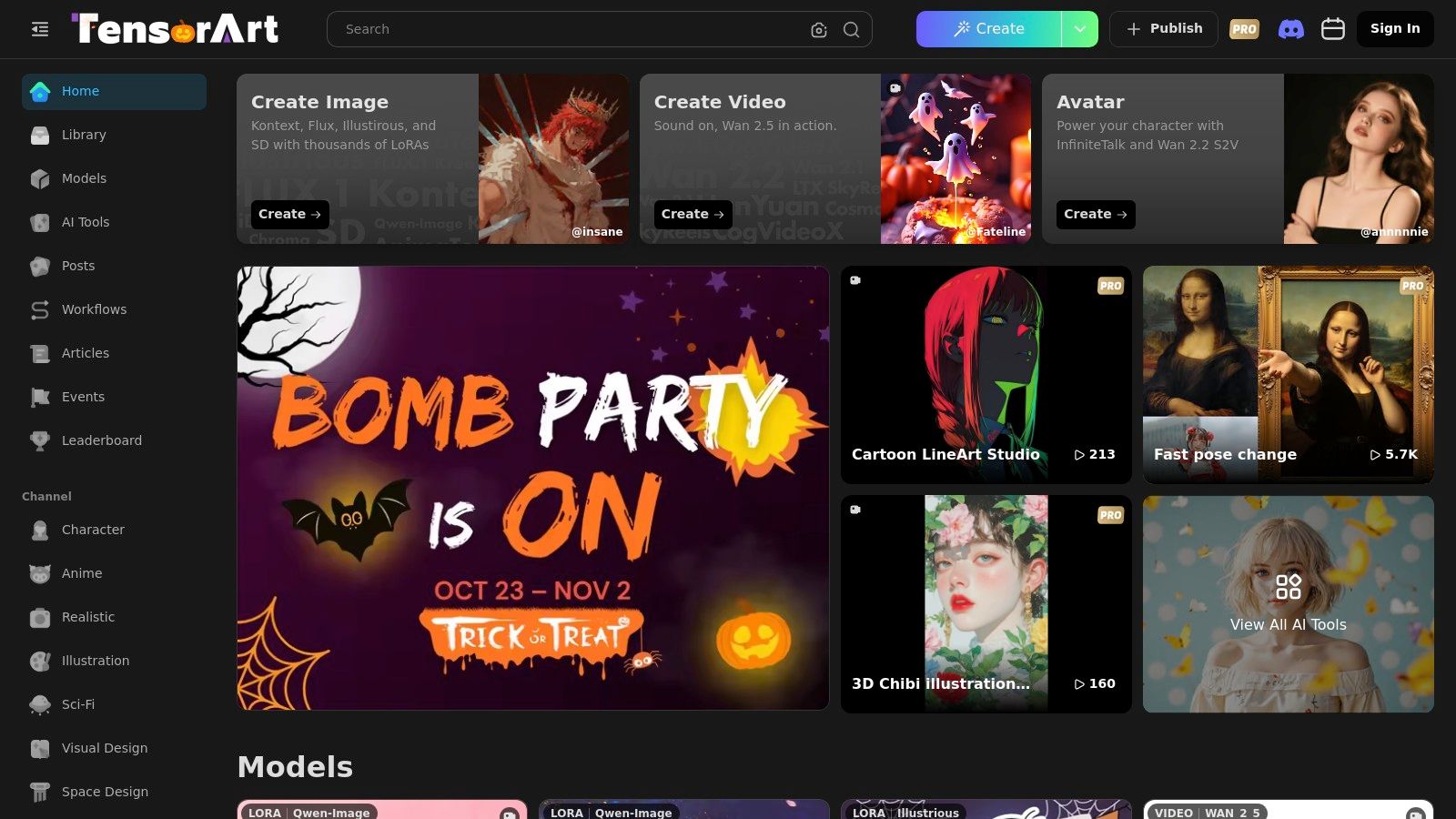
What makes Tensor.art stand out is its community-driven model and credit system. Users can earn free credits by participating in "missions" and engaging with the platform, providing a sustainable way to keep creating. While the open nature of the platform means the origin of community models can be unclear, requiring professional users to be diligent about licensing, its strength lies in the sheer variety it offers. It’s one of the best free AI image generators for hands-on experimentation and discovering unique community-built assets.
Key Features and Considerations
Website: tensor.art
12. OpenArt
OpenArt serves as a versatile creative hub, offering a flexible entry point into various AI image generation models. It provides free access to its own models and popular open-source engines like SDXL, making it an excellent platform for experimentation. For those wanting to test more advanced or proprietary models without a full subscription, OpenArt offers a paid credits system, allowing users to explore premium capabilities on a pay-as-you-go basis.
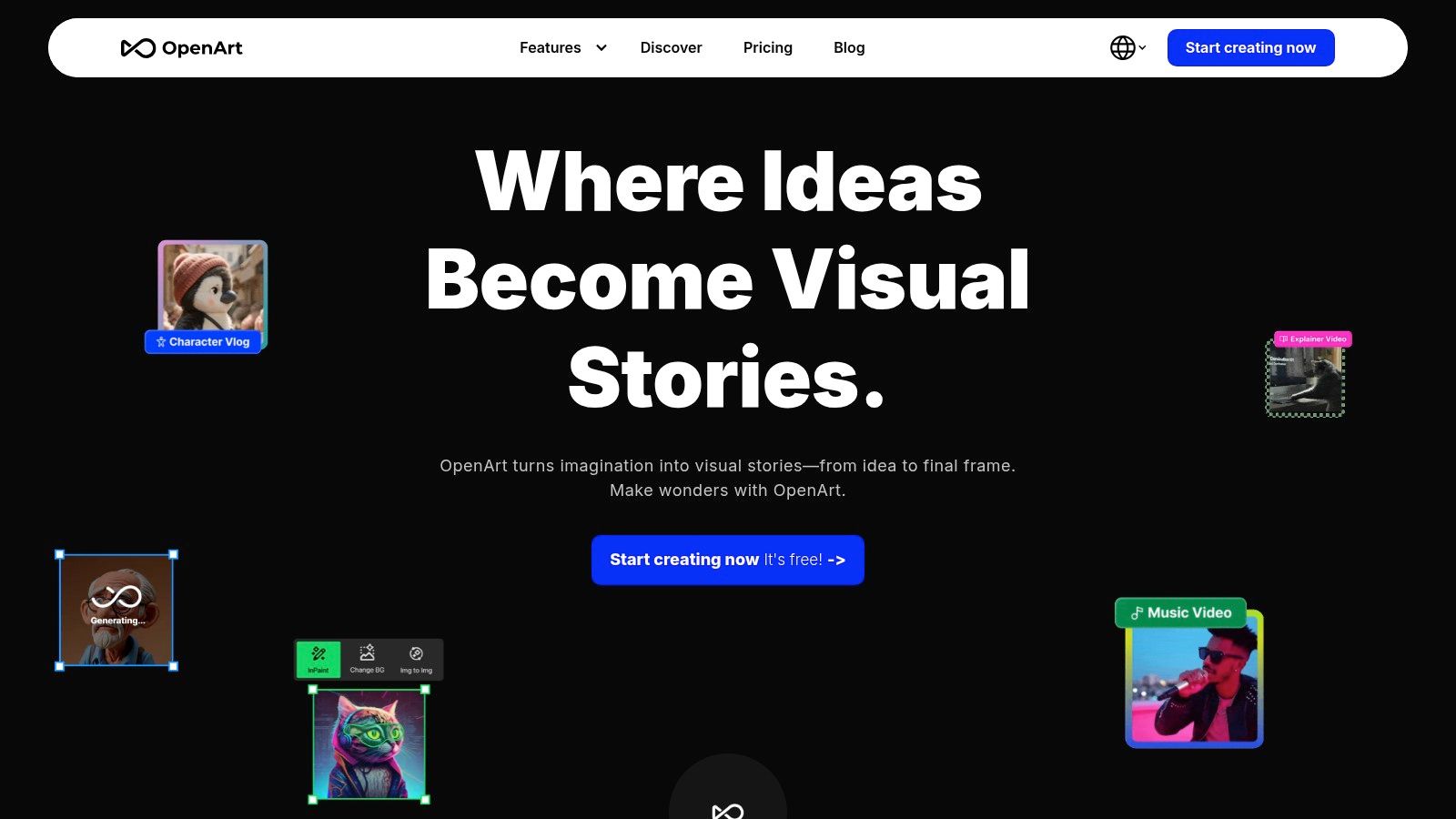
What distinguishes OpenArt is its focus on community and advanced workflows. The platform is not just a generator but also a learning resource, featuring community-created workflows, tutorials, and ComfyUI resources. This makes it one of the best free AI image generators for users looking to move beyond simple text-to-image prompts and understand the mechanics of building complex generation pipelines. The free plan, combined with trial and occasional promotional credits, provides ample opportunity to learn and create before committing financially.
Key Features and Considerations
Website: openart.ai
Top 12 Free AI Image Generators — Feature Comparison
Unifying Your Creative Workflow Beyond Free Tools
Navigating the landscape of the best free AI image generators reveals a powerful truth: generative AI is no longer a futuristic concept but a practical, accessible tool for creators today. From the commercially-safe outputs of Adobe Firefly to the typographic prowess of Ideogram and the community-driven models on Leonardo.ai, there is a free solution tailored to almost any initial creative spark.
We have explored a dozen distinct platforms, each with its unique strengths. Microsoft Designer offers seamless social media integration, Canva’s Magic Studio empowers non-designers, and advanced hubs like Hugging Face Spaces provide unparalleled access to specialised models for experimentation. The key takeaway is that the ideal tool is entirely dependent on your specific project requirements, technical comfort level, and long-term goals.
Selecting Your Starting Point
Choosing the right generator requires a clear understanding of your needs. Before committing to a platform, even a free one, consider these critical factors:
- Commercial Use Rights: Are the generated images licensed for commercial projects? Platforms like Adobe Firefly and Microsoft Designer are built with this in mind, while others may have ambiguous or restrictive terms. Always verify the licence before using assets in client work.
- Artistic Control and Style: Do you need photorealism, illustrative flair, or complex typography? Leonardo.ai and NightCafe offer extensive stylistic controls, whereas Ideogram excels at integrating text. Match the tool's core strength to your desired aesthetic.
- Workflow Integration: How will this tool fit into your existing process? A simple, one-off image might be perfect for Craiyon, but for projects requiring consistent assets, a platform with project organisation features like Leonardo.ai is more suitable.
- Generation Limits and Quality: "Free" often comes with limitations. Assess the daily or monthly credit allowances and the maximum output resolution. Ensure these align with your project's demands to avoid hitting a wall mid-creation.
Moving from Experimentation to Enterprise-Ready Production
While these free tools are exceptional for prototyping, individual tasks, and learning the art of prompt engineering, professional creative teams face a different set of challenges. Managing disparate tools, tracking asset versions, ensuring brand consistency, and maintaining legal compliance across a distributed team can quickly become unmanageable. The fragmentation of using multiple free services introduces inefficiencies and risks that can stall large-scale projects.
This is the critical point where a unified platform becomes not just a benefit but a necessity. For creative directors, project managers, and enterprise teams, the focus shifts from simple generation to a holistic, organised, and scalable creative lifecycle. Centralising your AI-powered workflow ensures that your team can move from initial concept to finalised, commercially-viable assets with speed, oversight, and security. It transforms generative AI from a collection of standalone gadgets into an integrated, powerhouse engine for your entire creative operation, paving the way for more ambitious and efficiently executed projects.
Ready to move beyond scattered tools and unify your team's creative process? Virtuall provides a centralised Creative OS where you can generate, organise, and collaborate on AI-generated images, 3D models, and video in one secure workspace. Explore how Virtuall can scale your creative production today.


